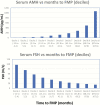Antimullerian Hormone and Impending Menopause in Late Reproductive Age: The Study of Women's Health Across the Nation
- PMID: 31965189
- PMCID: PMC7067546
- DOI: 10.1210/clinem/dgz283
Antimullerian Hormone and Impending Menopause in Late Reproductive Age: The Study of Women's Health Across the Nation
Abstract
Background: A test that helps predict the time to the final menstrual period (FMP) has been sought for many years.
Objective: To assess the ability of antimullerian hormone (AMH) measurements to predictions the time to FMP.
Design: Prospective longitudinal cohort study.
Setting: The Study of Women's Health Across the Nation.
Participants and measurements: AMH and FSH were measured in 1537 pre- or early perimenopausal women, mean age 47.5 ± 2.6 years at baseline, then serially until 12 months of amenorrhea occurred. AMH was measured using a 2-site ELISA with a detection limit of 1.85 pg/mL.
Main outcome measure: Areas under the receiver operating curves (AUC) for AMH-based and FSH-based predictions of time to FMP, stratified by age. Probabilities that women would undergo their FMP in the next 12, 24, or 36 months across a range of AMH values were assessed.
Results: AUCs for predicting that the FMP will occur within the next 24 months were significantly greater for AMH-based than FSH-based models. The probability that a woman with an AMH <10 pg/mL would undergo her FMP within the next 12 months ranged from 51% at h<48 years of age to 79% at ≥51 years. The probability that a woman with an AMH >100 pg/mL would not undergo her FMP within the next 12 months ranged from 97% in women <48 years old to 90% in women ≥51 years old.
Conclusions: AMH measurement helps estimate when a woman will undergo her FMP, and, in general, does so better than FSH.
Keywords: aging; female reproductive endocrinology; gonadotropins; inhibin/activin/follistatin/AMH; menopause; ovaries.
© Endocrine Society 2020. All rights reserved. For permissions, please e-mail: journals.permissions@oup.com.
Figures
Comment in
-
AMH as a Predictor of the Final Menstrual Period.J Clin Endocrinol Metab. 2020 Apr 1;105(4):dgaa025. doi: 10.1210/clinem/dgaa025. J Clin Endocrinol Metab. 2020. PMID: 31970419 No abstract available.
Similar articles
-
Anti-mullerian hormone and inhibin B in the definition of ovarian aging and the menopause transition.J Clin Endocrinol Metab. 2008 Sep;93(9):3478-83. doi: 10.1210/jc.2008-0567. Epub 2008 Jul 1. J Clin Endocrinol Metab. 2008. PMID: 18593767 Free PMC article.
-
Predicting the timeline to the final menstrual period: the study of women's health across the nation.J Clin Endocrinol Metab. 2013 Apr;98(4):1483-91. doi: 10.1210/jc.2012-3732. Epub 2013 Mar 26. J Clin Endocrinol Metab. 2013. PMID: 23533245 Free PMC article.
-
Individualized predictions of time to menopause using multiple measurements of antimüllerian hormone.Menopause. 2016 Aug;23(8):839-45. doi: 10.1097/GME.0000000000000642. Menopause. 2016. PMID: 27326817
-
Hormone changes associated with the menopausal transition.Minerva Ginecol. 2009 Dec;61(6):483-9. Minerva Ginecol. 2009. PMID: 19942836 Free PMC article. Review.
-
The menopausal transition--endocrinology.J Sex Med. 2008 Oct;5(10):2266-73. doi: 10.1111/j.1743-6109.2008.00921.x. Epub 2008 Jul 1. J Sex Med. 2008. PMID: 18624962 Review.
Cited by
-
Low anti-Müllerian hormone levels are associated with an increased risk of incident early-onset vasomotor symptoms among premenopausal women.Sci Rep. 2022 Jul 13;12(1):11904. doi: 10.1038/s41598-022-16182-7. Sci Rep. 2022. PMID: 35831405 Free PMC article.
-
Menopause and women's cardiovascular health: is it really an obvious relationship?Arch Med Sci. 2022 Dec 10;19(2):458-466. doi: 10.5114/aoms/157308. eCollection 2023. Arch Med Sci. 2022. PMID: 37034510 Free PMC article.
-
Modeling Variation in the Reproductive Lifespan of Female Adolescent and Young Adult Cancer Survivors Using AMH.J Clin Endocrinol Metab. 2020 Aug 1;105(8):2740-51. doi: 10.1210/clinem/dgaa172. J Clin Endocrinol Metab. 2020. PMID: 32270202 Free PMC article.
-
Investigating the Clinical Utility of the Anti-Mullerian Hormone Testing for the Prediction of Age at Menopause and Assessment of Functional Ovarian Reserve: A Practical Approach and Recent Updates.Aging Dis. 2022 Apr 1;13(2):458-467. doi: 10.14336/AD.2021.0825. eCollection 2022 Apr. Aging Dis. 2022. PMID: 35371603 Free PMC article. Review.
-
Circulating anti-Müllerian hormone levels in pre-menopausal women: novel genetic insights from a genome-wide association meta-analysis.Hum Reprod. 2024 May 30;39(7):1564-72. doi: 10.1093/humrep/deae117. Online ahead of print. Hum Reprod. 2024. PMID: 38815977 Free PMC article.
References
-
- Oeppen J, Vaupel JW. Demography. Broken limits to life expectancy. Science. 2002;296(5570):1029–1031. - PubMed
-
- Gold EB, Bromberger J, Crawford S, et al. Factors associated with age at natural menopause in a multiethnic sample of midlife women. Am J Epidemiol. 2001;153(9):865–874. - PubMed
-
- Hurwitz JM, Santoro N. Inhibins, activins, and follistatin in the aging female and male. Semin Reprod Med. 2004;22(3):209–217. - PubMed
Publication types
MeSH terms
Substances
Grants and funding
LinkOut - more resources
Full Text Sources
Medical


